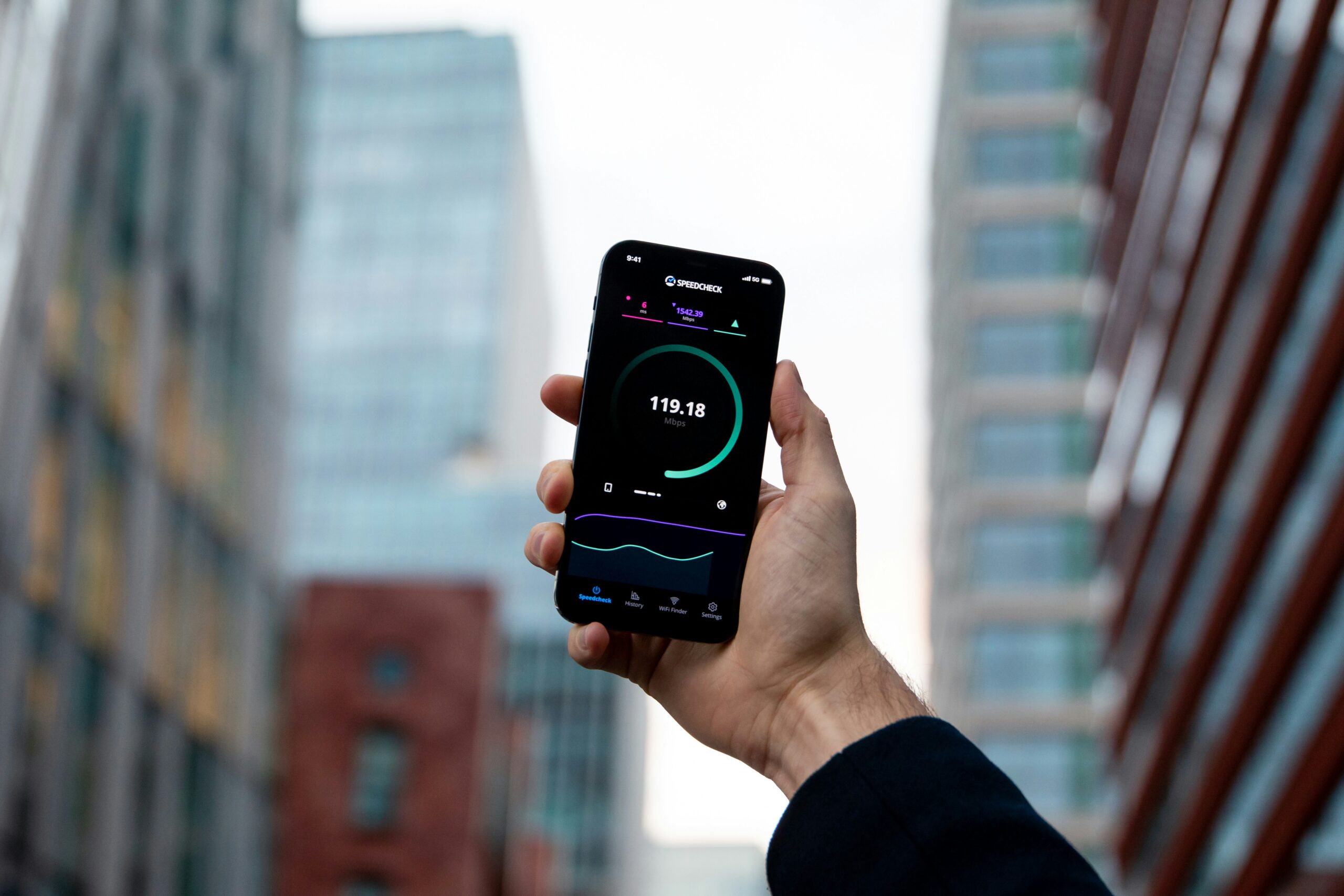
5G is divided into 3 different frequency bands each bringing something different to the table. If you’re looking to learn how 5G technology works, you’ve landed at the right place.
At Elevate Wireless, we are highly experienced in helping industrial automation specialists optimize their network’s wireless capabilities. In this article, we’ll tell you all you need to know about 5G connectivity and how it can impact your enterprise’s network.
In the landscape of 5G technology, understanding the characteristics of different frequency bands is fundamental. High-frequency bands and spectrum, utilized in 5G networks, are capable of transmitting data at remarkably fast rates, making them suitable for applications requiring rapid connectivity.
However, their higher frequencies have a shorter effective range and are more easily obstructed by physical barriers. In contrast, low-frequency bands provide extensive coverage and superior penetration through obstacles, attributes that contribute to their ability to deliver service over large distances. Yet, they inherently support lower data speeds due to their reduced bandwidth. Grasping these attributes is crucial for appreciating how various types of 5G networks are designed to meet specific communication needs.
The Spectrum of 5G Technology
Low-Band 5G: Foundational Nationwide Coverage
At the foundation of the 5G spectrum lies the low-band 5G, operating on sub-1 GHz frequencies. This segment of the radio spectrum is not new to the world of cellular networks; it has been the backbone of 4G LTE, providing extensive coverage across vast distances. The magic of low-band frequencies lies in the ability to penetrate obstacles and cover wider regions, making this spectrum ideal for proving broad accessibility, especially in rural and remote regions where connectivity challenges are most pronounced.
Despite its wide reach, low-band 5G does not boast the high data transfer speeds we normally associate with the 5G revolution. Instead, it offers a modest improvement similar to 4G LTE, positioning itself as a reliable fallback for basic connectivity needs and extending cell networks into areas that cannot justify additional towers or where tower network expansion is simply impractical.
Mid-Band 5G: Sweet Spot for Speed and Coverage
Ascending the frequency spectrum, mid-band 5G operates within the 1GHz–6GHz range. This segment strikes a balance between speed and coverage, offering faster data transfer rates than low-band 5G without sacrificing the ability to cover significant distances. Mid-band 5G is the heart of enhanced mobile broadband, providing the capacity and speed needed to support the higher data demands of suburban and urban areas.
The application of mid-band frequencies in cellular networks showcases the versatility of the 5G technology. It caters to a wide array of uses, from streaming high-definition video to enabling complex industrial applications that require quick, reliable connectivity, and low latency. Mid-band 5G offers an optimal blend of performance and accessibility that makes it a central piece of the 5G rollout in many regions around the world.
High-Band 5G (mmWave): The Ultimate Speed
At the peak of the 5G frequency spectrum lies the high-band 5G, or millimeter wave (mmWave), which operates in the 24GHz–40GHz frequency range. This segment of the radio spectrum is where 5G truly distinguishes itself from previous generations, offering ultra-high data transfer speeds that can exceed 1 Gbps. The trade-off for this remarkable performance is a limited range and reduced ability to penetrate buildings and other obstacles, confining its use to densely populated areas and specific applications that demand high bandwidth.
The high-band spectrum enables applications that were previously unthinkable, such as real-time augmented reality experiences and ultra-fast wireless broadband that rivals fiber optic cables in speed but without the need for physical connections. However, the deployment of mmWave technology requires a dense network of antennas and repeaters to overcome its limitations, making it a significant investment for network operators.
Understanding 5G Bands and Their Importance
The advent of 5G has introduced a complex blend of frequency bands, each playing an important role in the orchestration of a global network that promises unprecedented connectivity. Understanding these 5G frequency bands is crucial, as they are the foundation upon which the diverse applications and benefits of 5G technology are built. The strategic deployment of these bands is what allows 5G networks to optimize performance, coverage, and reliability.
The Strategic Application of Frequency Bands
Low-Band 5G
- Broad, national coverage for basic internet access across rural and remote areas.
- IoT applications require wide coverage but not high bandwidth, such as agricultural sensors or smart meters.
Mid-Band 5G
- Urban and suburban connectivity with a balance of speed and coverage.
- Enhanced mobile broadband (eMBB) for residential and commercial use, supporting streaming, gaming, and video conferencing.
- Smart city applications, including traffic management and public safety networks.
High-Band 5G (mmWave)
- High-density areas such as stadiums, campuses, and urban centers where very high data rates are required.
- Ultra-reliable low-latency communications (URLLC) for industrial automation, telemedicine, and AR/VR experiences.
- Massive IoT deployments where a large number of devices require high-speed data transfer.
How Do I Access Different 5G Bands?
Accessing different 5G bands is seamless for end-users. Your 5G device automatically navigates between bands to ensure optimal connectivity without any manual intervention. Most 5G devices are equipped with multiple antennas, enabling them to support a variety of frequency bands simultaneously, ensuring you’re always connected to the best available network.
Overcoming Environmental Challenges
One of the most significant challenges in deploying 5G networks is the variability of the environment. Buildings and trees can affect the propagation of radio waves, influencing the performance of the network. The three frequency bands of 5G each react differently to these obstacles. High band frequencies, for example, are particularly susceptible to attenuation, meaning their signals can be easily blocked by physical barriers.
To overcome these challenges, network operators are employing innovative technologies and strategies. Beamforming, an advanced signal processing technique, allows for more precise targeting of radio waves, improving the efficiency and reach of radio frequencies. Dynamic spectrum sharing enables operators to use the same frequency bands for both 4G and 5G, maximizing the utility of the available spectrum. Additionally, the deployment of small cells—low-powered radio access nodes—is crucial for expanding the reach of band frequencies, especially high band frequencies, and ensuring that the promise of mmWave technology can be realized even in challenging urban environments.
The strategic application of 5G bands in private networks is also of great importance. In scenarios where traditional public networks may struggle, such as in densely packed industrial complexes or sprawling campuses, private 5G networks can be tailored to meet specific needs. By carefully selecting the appropriate frequency bands, these networks can offer the reliability, speed, and coverage necessary to support a wide range of applications, from automated manufacturing processes to campus-wide connectivity solutions.
Examples Across Different Sectors
The impact of choosing the right 5G type extends across various sectors, each with its unique demands:
- Healthcare: In hospitals, where the need for both reliability and high data transfer speeds is critical, mid-band 5G can support telemedicine applications, allowing for remote diagnostics and consultations without lag or interruption.
- Manufacturing: Factories leveraging automation and IoT technologies benefit from the low latency and high reliability of mid-band and high-band 5G networks. These networks facilitate real-time monitoring and control of manufacturing processes, enhancing efficiency and reducing downtime.
- Transportation: For the transportation sector, low-band 5G provides the extensive coverage necessary for tracking vehicles across long distances, while high-band 5G supports autonomous vehicle technologies in urban areas, where precision and speed are paramount. Combining this with Bluetooth asset trackers can lead to game-changing visibility and productivity.
- Entertainment and Media: In stadiums and concert venues, high-band 5G (mmWave) can deliver ultra-high-speed internet access to thousands of users simultaneously, enabling immersive augmented reality experiences and high-definition live streaming.
By understanding the specific needs of your sector and the capabilities of different 5G bands, you can ensure that your network infrastructure is optimized for your current operations and future innovations.
RUTM50 5G Cellular Router: A Gateway to Advanced Connectivity
Certified by the FCC for North America, the Teltonika RUTM50 is designed to propel your industrial network into the next generation of connectivity with ultra-high cellular speeds of up to 3.4 Gbps. Its dual SIM capability, complete with auto-failover and backup WAN, ensures uninterrupted service, while support for both SA and NSA 5G architectures, along with backward compatibility with LTE Cat 19, guarantees your network is future-proof.
Key Features at a Glance:
- Ultra-High Speeds: Achieve breakthrough speeds up to 3.4 Gbps, ensuring your operations are powered by the fastest cellular technology available.
- Dual SIM with Auto-Failover: Enhances network resilience, automatically switching between SIMs based on signal strength and predefined rules to manage data costs effectively.
- Advanced Security: Equipped with state-of-the-art encryption protocols and comprehensive security features, including DDOS prevention and customizable access controls, the RUTM50 secures your data against emerging cyber threats.
- Rugged Industrial Design: Built to withstand extreme temperatures and conditions, ensuring reliable operation in any industrial environment.
The RUTM50 is a versatile, secure, and durable solution designed to meet the demands of modern industrial applications. With its advanced features and robust design, the RUTM50 will ensure your network remains at the forefront of technological advancement.
Future-Proof Your Industrial Network with Elevate Wireless
Embracing the full spectrum of 5G technology is crucial for keeping your business ahead of your competition. Elevate Wireless is more than just a provider of cellular technology solutions, we are your trusted partners for optimal 5G integration. Our goal is to understand your unique needs and to tailor solutions that not only future-proof your network but also align with your strategic business goals.If you’re ready to take the next step in upgrading your network infrastructure, contact our team today. We’re here to guide you through selecting the optimal network solutions to ensure your network stays ahead of the curve.
